based on E.H. Nickel & M.C. Nichols (2009), H. Strunz & E.H. Nickel (2001),
revised by Thomas Witzke (2023)
5. CARBONATES
(Carbonates, Nitrates)
5.E: Uranylcarbonates
Bayleyite: the structure consists of isolated uranyl tricarbonate anions [UO2(CO3)3]4-, magnesium hexahydrate octahedra [Mg(H2O)6]2+ and free water molecules (Colmenero et al., 2020, Spectrochim. Acta A)
Swartzite: isolated clusters of the composition Ca(H2O)6[UO2(CO3)3]2-, formed of uranyl tricarbonate anions [UO2(CO3)3]4- and Ca(H2O)6O2 square antiprisms, sharing edges with the uranyl tricarbonate groups. Isolated Mg(H2O)22+ octahedra are linked via a system of hydrogen bonds to the clusters (Mereiter, 1986, N. Jb. Min. Mh., 481-492).
Čejkaite: uranyl tricarbonate anions [UO2(CO3)3]4-, Na in octahedral and pentagonal coordination, with oxygen from carbonate groups and apical oxygen from hexagonal UO8 bipyramids (Ondruš et al., 2015, Am. Min. 88, 686-693).
Leószilárdite: uranyl tricarbonate anions [UO2(CO3)3]4-, linked by irregular chains of NaO5(H2O) polyhedra and by three-octahedron units consisting of two Na-centred octahedra that share the opposite faces of a Mg-centred octahedron at the centre, and have the composition Na2MgO12(H2O)4 (Olds et al., 2017, Min. Mag. 81, 1030-1050).
Andersonite: uranyl tricarbonate anions [UO2(CO3)3]4- connected to polyhedra with Ca in 7-fold coordination and Na centered distorted octahedra forming together with additional, more distorted NaO2(H2O)4 octahedra (with two splitted water positions) columnar, well-like units with zeolite-like channels in c direction. The channels are occupied by water (Gurzhiy et al., 2018, Minerals 8, 586).
Grimselite: uranyl tricarbonate anions [UO2(CO3)3]4- linked into layers via NaO8 hexagonal bipyramids. Each NaO8 polyhedron shares three equatorial edges with (CO3) groups so that one oxygen is shared between the UO8 and NaO8 polyhedra and a carbonate group. The resulting heteropolyhedral layers are stacked along [001]. Adjacent layers are linked by sharing apical oxygen of UO8 and NaO8 hexagonal bipyramids. Voids in the resulting heteropolyhedral framework contain K cations and H2O groups (Li & Burns, 2001, Can. Min. 39, 1147-1151).
Liebigite: uranyl tricarbonate anions [UO2(CO3)3]4-, linked by CaO4(H2O)4 and CaO3(H2O)4 polyhedra to form puckered layers of the composition Ca2(UO2)(CO3)3·11H2O. The layers are interconnected by hydrogen bonds, both directly and via 3 interlayer water molecules per formula unit (Mereiter, 1982, Z. Krist, 30, 277-288).
Shabaite-(Nd): new formula and crystal system according to a structure determination. The structure contains uranyl tricarbonate anions [UO2(CO3)3]4-, Ca polyhedra and infinite layers of Nd polyhedra. The layers are oriented perpendicular to c (Plášil & Škoda, 2017, J. of Geosciences 62, 97-105).
Línekite: uranyl tricarbonate anions [UO2(CO3)3]4- and Ca centered polyhedra forming layers stacked along (100). Four uranyl tricarbonate groups are connected by Ca polyhedra forming a "paddlewheel" motive. Each uranyl tricarbonate group belongs to two paddlewheels (Plášil et al., 2017, J. of Geosciences 62, 201-213).
Albrechtschraufite: uranyl tricarbonate anions [UO2(CO3)3]4-, MgF2O3(H2O) octahedra, CaFO6, CaF2O2(H2O)4, CaFO3(H2O)4 and CaO2(H2O)6 polyhedra. Four uranyl tricarbonate groups are connected by Ca polyhedra forming a "paddlewheel" motive. The crystal structure is built up from MgCa3F2[UO2(CO3)3]·8H2O layers parallel to (001) which are linked by Ca[UO2(CO3)3]·5H2O moieties into a framework. Five additional water molecules are located in voids of the framework (Mereiter, 2012, Miner. Petrol. 107, 179-188).
Paddlewheelite: One of the minerals with the most complex crystal structure. Four uranyl tricarbonate anions [UO2(CO3)3]4-, linked by CaO8 cubes and CuO5 to a "paddlewheel" motive. The paddlewheels are connected by Ca polyhedra in 7- and 8-fold coordination. Mg is in octahedral coordination in pores petween the paddlewheels (Olds et al., 2018, Minerals 8, 511).
Ježekite: uranyl tricarbonate anions [UO2(CO3)3]4-, forming with Na cations in 8-fold coordination ordered {Na2[(UO2)(CO3)3]}2- sheets, alternating with a an interlayer with six Na+ ions plus highly disordered sheets of composition {[(SO4)2(H2O)3]}4- (Plášil et al., 2015, J. of Geosciences 60, 259-267).
Schröckingerite: the structure contains NaCa3[(UO2)(CO3)3] (SO4)F·6H2O layers built up from uranyl tricarbonate anions [UO2(CO3)3]4-, NaO3(H2O)3 octahedra, three kinds of CaO5F(H2O)2 polyhedra, Ca3F pyramids and Ca-bonded SO4 tetrahedra. The layers are stacked along the c direction and linked by hydrogen bonds, both directly as well as via interlayer H4O molecules (Mereiter, 1986, Tscherm. Min. Petr. Mitt. 35, 1-18).
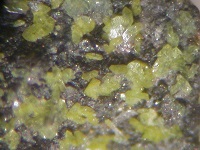 | 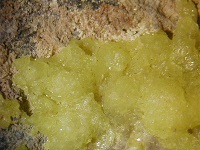 | 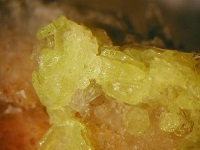 |  |
Ewingite: is regarded as the most complex mineral known at time (Nov. 2023). The structure contains nanometer-scale anionic uranyl carbonate cages that contain 24 uranyl polyhedra, as well as Ca and Mg cations. Water is located in interstitial regions inside and between the cages. The cage contains three building blocks, (1) a trimer of corner-sharing pentagonal UO7 bipyramids, forming a cluster [U3O16], (2) uranyl tricarbonate groups [UO2(CO3)3] and (3) the uranyl ion is coordinated by two carbonate groups and two H2O groups in the equatorial region of a hexagonal bipyramid [UO2(CO3)2(H2O)2] (as in uranyl tricarbonate groups, but one carbonate is replaced by two H2O). Ca and Mg cations are situated inside the cages, but link also the cages (Olds et al., 2017, Geology 45, 1007-1010).
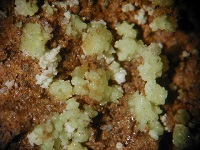 |  |  |  |
Widenmannite: the ideal structure contains chains of corner-sharing hexagonal UO8 bipyramids. Each bipyramide shares an edge with a carbonate group, a second carbonate group is shared between two bipyramids (can also be described as chains of uranyl tricarbonate groups with an "overlapping" carbonate). The uranyl carbonate chains are interconnected by a network of Pb-O bonds. In the real structure, around 7 % of the U positions in the chains are not occupied, instead a second U centered hexagonal bipyramide connect the chains, accompanied by a vacant Pb site (Plášil et al., 2014, Am. Min. 99, 276-282).
 |  |  |
Fontanite: structure is based on the phosphuranylite anion topology. The structure contains chains of two symmetrically distinct uranyl pentagonal bipyramids (forming a dimer), one uranyl hexagonal bipyramid, and two CO3 triangles. The dimers are oriented perpendicular to the chain direction and are connected sharing equatorial edges with hexagonal bipyramids. The CO3 groups occur on either side of the chains, where they share equatorial edges of the uranyl hexagonal bipyramids, and share their third ligand with a uranyl pentagonal bipyramid of an adjacent chain. The arrangement resulting in uranyl carbonate sheets of composition [(UO2)3(CO3)2O2]2-. The Ca2+ cation is located between the sheets, and is coordinated by two O atoms of uranyl ions of adjacent sheets, and six H2O groups Hughes & Burns, 2003, Am. Min. 88, 962-966).
Roubaultite: structure is based on the phosphuranylite anion topology. Chains of alternating hexagonal bipyramids and dimers of pentagonal bipyramids. The chains are connected to layers via distorted Cu centered octahedra (Ginderow & Cesbron, 1985, Acta Cryst. C41, 654-657).
Bijvoetite-(Y): pseudo-orthorhombic. Complex chains of pentagonal and hexagonal U centered bipyramids in [100] direction. The chains are connected via irregular REE centered polyhedra to layers parallel (010). A part of the water belongs to the REE polyhedra. Adjacent layers are connected by H bonds only from interlayer water (Li et al., 2000, Can. Min. 38, 153-162).
Kamotoite-(Y): pseudo-orthorhombic supercell, identical to the cell of Bijvoetite-(Y). The crystal structure topology is the same as in Bijvoetite-(Y). It might be that the two minerals are identical (Plášil & Petřiček, 2017, Min. Mag. 81, 653-660).
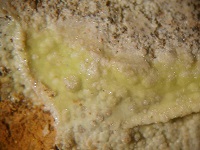 |  |  |  |
Wyartite: structure is a derivative of the beta-U3O8 topology. The mineral contains layers composed of U6+O7 pentagonal bipyramids and U5+O6 square bipyramids.
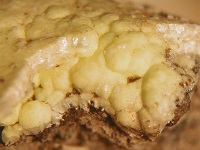 |  |  |  |
Rutherfordine: neutral sheets of edge- and corner-sharing (UO8) hexagonal bipyramids and CO3 groups (Finch et al., 1999, Can. Min. 37, 929-938).
Sharpite: the topology of the sheets is identical to rutherfordine. The structure is based upon infinite Ca2+-uranyl-carbonate sheets with hexagonal bipyramids UO8 and . Ca2+(H2O)3O5. Ca2+ is occupying one of the U6+ positions in the sheets. The sheets are extremely corrugated, stacked perpendicular to b and linked by H-bonds and Van Der Waals interactions, only (Plášil, 2018, Z. Krist. 233, 579-586).
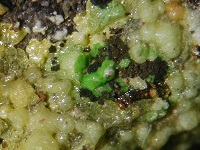 | 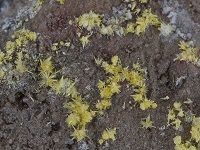 | 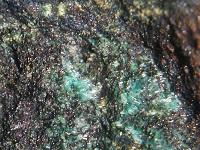 |  |
Urancalcarite: crystal structure not known.
Oswaldpeetersite: crystal structure not known.
Blatonite: crystal structure not known.
Joliotite: crystal structure not known.
Zellerite and Metazellerite: crystal structure not known.
Voglite: crystal structure not known.
Rabbittite: crystal structure not known. The mineral probably contains Fluorine. Re-study of type material necessary. The ratio of (UO2) : (CO3) = 1 : 3 suggest that the mineral might contain uranyl tricarbonate anions [UO2(CO3)3]4-.
Crystal structure not published yet, in press. Steciuk, G., Majzlan, J., Rohlícek, J., Skoda, R., Sejkora, J., Plásil, J. (2023): Znucalite, the only known zinc uranyl carbonate: its crystal structure and environmental implications. American Mineralogist, 108, (in press).
Astrocyanite-(Ce): crystal structure not known.
 |  |  |
G = Grandfathered minerals: original description preceded the establishment of the CNMNC in 1959, and generally regarded as a valid species
A or IMA No. = Minerals approved by the CNMNC
Rd = Redefinition of the mineral approved by the CNMNC
Rn = Renamed with approval by the CNMNC
Q = Questionable mineral
Classification principles:
Subdivision of the Carbonates subclass "5.E: Uranylcarbonates" completely re-arranged compared to the chemical classification in Strunz 9. The subdivision is based now on structural aspects, the arrangement of UOn polyhedra: 5.EA. With finite clusters of hexagonal UO8 bipyramids: with uranyl tricarbonate [UO2(CO3)3]4- groups or [U2O6(CO3)4]8- groups; 5.EB. With arrangements of uranyl tricarbonate groups [UO2(CO3)3]4- and pentagonal UO7 bipyramids; 5.EC. With chains of hexagonal UO8 bipyramids; 5.ED. With complex chains of pentagonal UO7 and hexagonal UO8 bipyramids, connected to sheets by carbonate groups or other anion centered polyhedra; 5.EE. Structures containing sheets based on tetragonal UO6 and pentagonal UO7 bipyramids; 5.EF. Structures containing sheets based on hexagonal UO8 bipyramids; 5.EG. Uranylcarbonates with unknown crystal structure.
Further classification:
|
5.EA. With finite clusters of hexagonal UO8 bipyramids: with uranyl
tricarbonate
[UO2(CO3)3]4- groups
or [U2O6(CO3)4]8-
groups:
Sorted according to the arrangement of uranyl tricarbonate (UTC) groups and other cation
centered polyhedra. Isolated UTC groups (Bayleyite); isolated clusters of UTC groups with
other polyhedra (Swartzite); UTC groups connected by other polyhedra; UTC groups and other
polyhedra in layered structures (Liebigite and related minerals, Shabaite-(Nd)); UTC groups
arranged in a paddlewheel motive; carbonates with UTC groups and additional tetrahedral anions;
with [U2O6(CO3)4]8-
groups. 5.EB. With arrangements of uranyl tricarbonate groups [UO2(CO3)3]4- and pentagonal UO7 bipyramids: Only two minerals, arranged with increasing complexity. 5.EC. With chains of hexagonal UO8 bipyramids: Only one mineral. 5.ED. With complex chains of pentagonal UO7 and hexagonal UO8 bipyramids, connected to sheets by carbonate groups or other anion centered polyhedra: Minerals with phosphuranylite sheet topology; minerals with related sheets. 5.EE. Structures containing sheets based on tetragonal UO6 and pentagonal UO7 bipyramids: Only one mineral. 5.EF. Structures containing sheets based on hexagonal UO8 bipyramids: Rutherfordine type sheets and derivative. 5.EG. Uranylcarbonates with unknown crystal structure: Sorted with increasing carbonate content. |
To distinguish from classical Strunz numbering, on hierarchical "group" level, a numbering with 3 digits is used, like "5.EA.005. Bayleyite", instead of 2 digits (like "5.EA.05.") in the Strunz system.
Used references:
Burns, P. (2005): U6+ minerals and inorganic compounds: insights into an expanded structural hierarchy of crystal structures. Can. Min. 43, 1839-1894.
© Thomas Witzke (2023)
